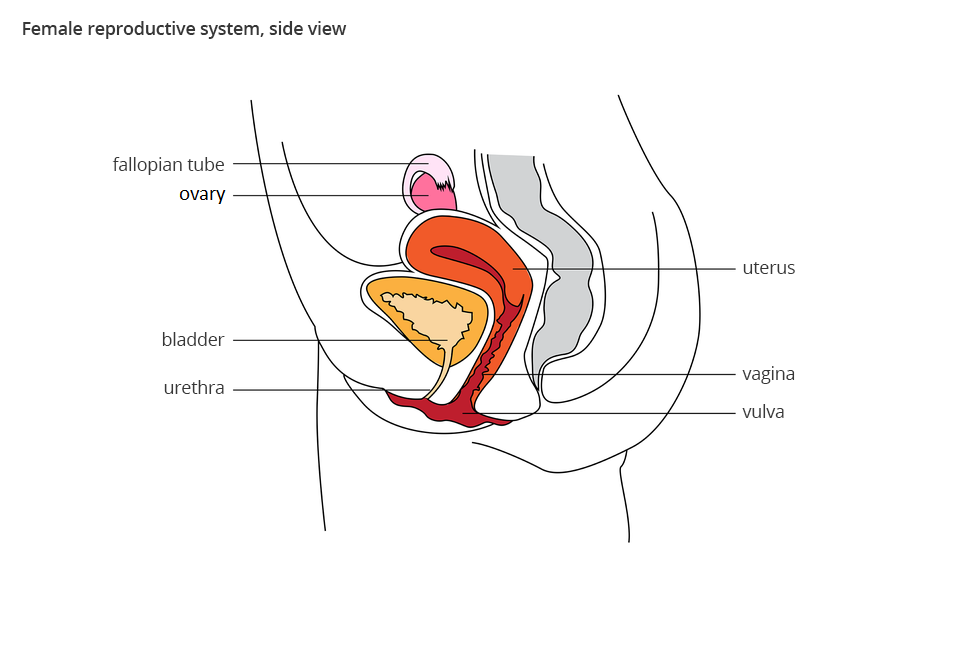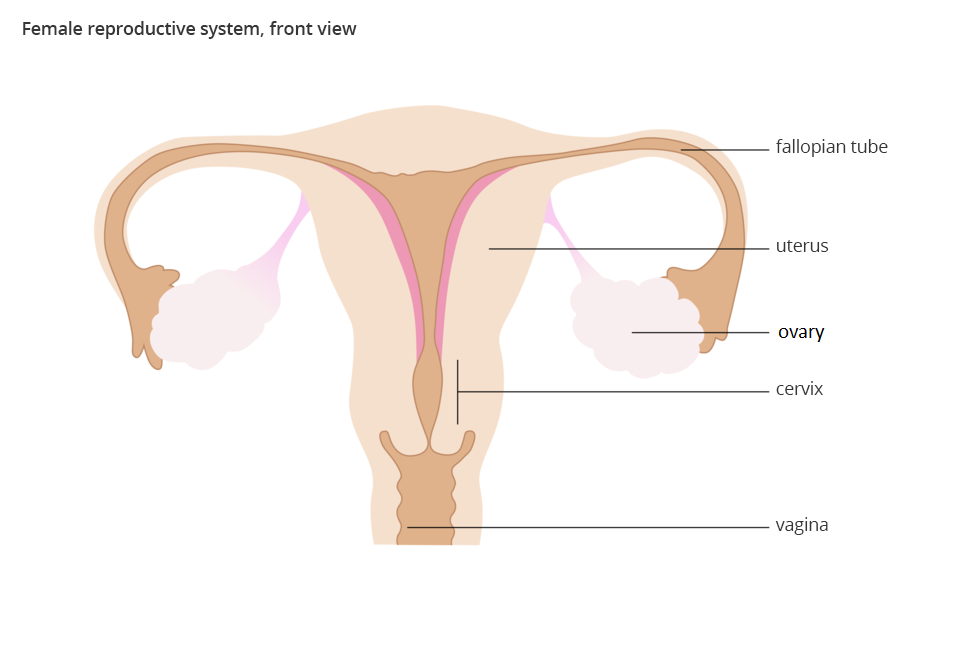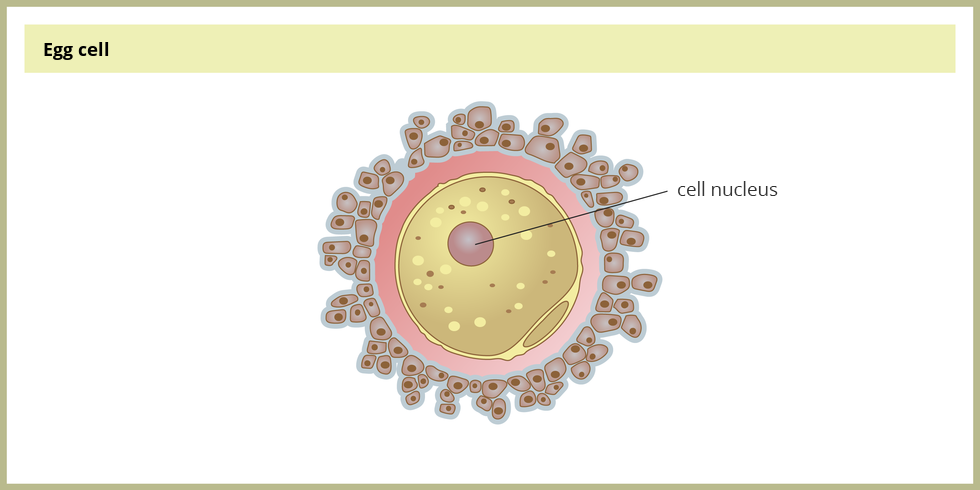Female and male reproductive system
there are two types of reproduction – sexual and asexual;
hormones play an important role in reproduction and development;
sexual reproduction involves gametes: egg cell and sperm (spermatozoid).
discuss sexual characteristics;
recognize the organs of the female and male reproductive systems;
discuss the functions of the genital organs;
compare the structure of the sperm (spermatozoid) and egg cell.
Nagranie dostępne na portalu epodreczniki.pl
Nagranie dźwiękowe dotyczące żeńskiego i męskiego układu rozrodczego
Sexual features
Reproduction, or giving birth to offspring and ensuring the continuity of the species, is the most important task of the reproductive system to which the human body is properly adapted.
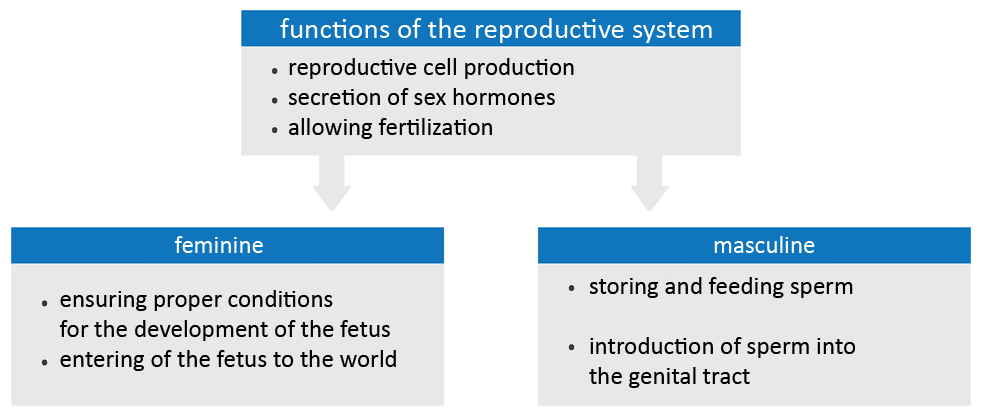
Sexual features are divided into primary, secondary and tertiary. Primary and secondary characteristics are internal and external organs of the reproductive system. In the internal organs is the production of reproductive cells and their transport, in the female organs also the development of the fetus. External genital organs are involved in the transmission of reproductive cells. Tertiary features are not directly related to the act of reproduction and are mainly related to differences in the appearance and behavior of women and men.
Categories | female | male |
primary | ovary | testicles |
secondary | fallopian tubes, uterus, vagina, vulva | scrotum, penis, vas deferens |
tertiary | wide hips | narrow hips |
narrow arms | wide shoulders | |
high voice | low voice | |
developed mammary glands | facial hair |
Explain how the development of sexual characteristics is subject to hormonal regulation.
Female reproductive system
The female reproductive system produces female gametesgametes – egg cells– and creates conditions for fertilization and development of the embryo and later the fetus. We divide the female reproductive organs into external and internal ones.
The external genital organs are:
pubic mound, built of fat, covered with pubic hair;
labia smaller and larger (vulva), which in the form of skin folds protect the entrance to the vagina and the outlet of the urethra;
clitoris, which contains particularly many sensory cells that enhance sexual arousal.
The internal genital organs include:
ovaries –organs of the size of plums with ovarian follicles; each of them contains an egg cell at various stages of development; when the egg matures, it breaks and releases, and this goes to the fallopian tube;
Fallopian tube, from the ovary which takes the form of a funnel; this structure makes catching the egg easier; the walls of the fallopian tube are made of smooth muscle and lined with ciliated epithelium; muscle contraction and cilia movement allows the egg to move towards the uterus, which connects the other end of the fallopian tube;
uterus – an organ whose walls are built of highly developed smooth muscle tissue and covered with a thick layer of mucous membrane allowing the implantation of the embryo; muscles during pregnancy extend, adjusting the size of the uterus to the size of the developing fetus; during the birth they shrink, helping the child to leave the mother's body; the uterus has the shape of a pear; its wider part, called the stem, is directed upwards, the bottom, narrower, forms the downward facing neck;
vagina – muscular passage of the one part comprising the cervix and the other opens out on the outside; through the vagina to the genital track the male reproductive cells enter; this is also where menstrual blood is discharged, and during childbirth through the vaginal canal, the child enters into the world.
Heavy and large the egg is deprived of the ability of to move. Indicate the features of the structure of the female reproductive system, which are adaptation to the transport of reproductive cells.
Male reproductive system
The male reproductive system is responsible for the production of sperm (spermatozoid) and male sex hormones and the introduction of male reproductive cells into the female reproductive tract. It is made of external and internal organs.
The external sexual organs are:
scrotum –a thin, hair‑covered dermal‑muscular bag, in which there are testicles, epididymides and the initial parts of vas deferens;
penis has a dual role: it is part of the urinary system, because it contains the urethra, it is also an organ that introduces gametes to the female genital tract; in the penis there are sinuses to which blood may flow in, causing it to stiffen and enlarge; this state is called erection and enables sexual act.
The internal sexual organs include:
testicles – glands made of long and thin seminal tubules, in which male reproductive cells – sperm (spermatozoid) are produced; between the tubules are the cells that produce male sex hormones; the presence of these hormones in the fetal life determines the appearance of primary and secondary male sex characteristics;
epididymis – organs adjacent to the testicles in which sperm (spermatozoid) are stored;
vas deferens, that start in the epididymis and lead the sperm to the urethra; the secretions of seminal vesicles and prostate gland are also discharged into the vas deferens; it contains nutrients and stimulates sperm to move in the female reproductive track and allows them to reach the egg cell; sperm suspension in liquid secretion of seminal vesicles and prostate is called semen (sperm).
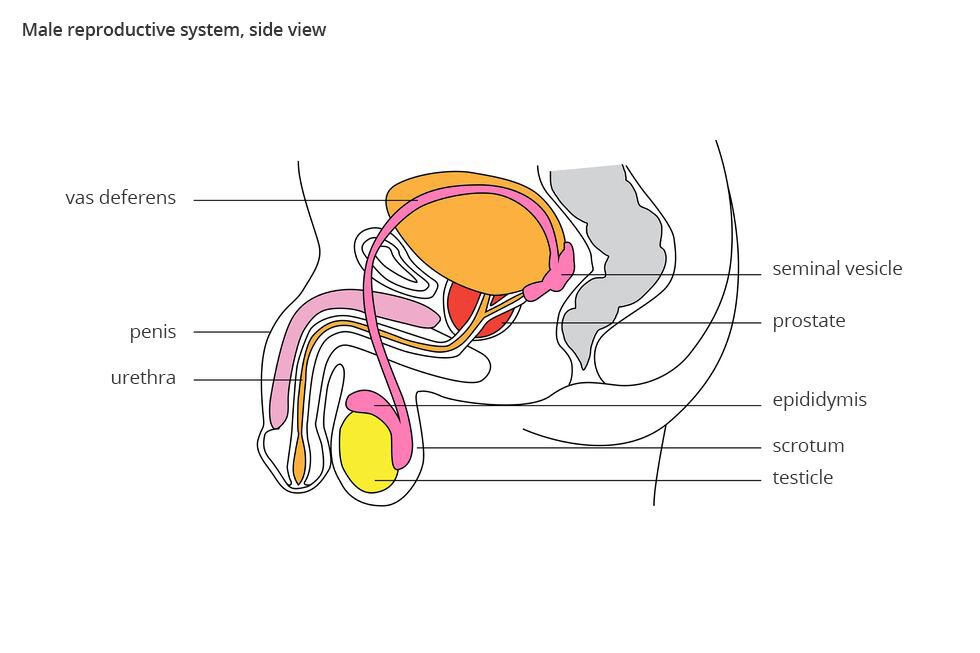
The urethra in women is shorter, in men longer. Explain why there is a difference.
Gametes
The female gamete, or the reproductive cell, is the egg cellegg cell. It does not have the ability to move and is the largest of human cells. It ripens on average every 28 days in the ovarian follicle, most often in one ovary, alternately – once in the left, once in the right. When the egg cells matures too much, there is a chance that dizygotic twins will be created during the fertilization process. Capable of fertilization, a mature egg cell contains egg yolk, which is a nourishing material for the embryo. The embryo will use it until it is implanted in the endometrium. The movement of female gametes in the fallopian tube takes 72 hours. After this time, it loses her ability to be fertilized.
Mature spermatozoid (sperm)spermatozoid (sperm) is made of a head, tail and acrosome. The tail is the longest part of the sperm (spermatozoid) and allows it to actively move towards the egg cell. The energy needed for movement arises in the mitochondria that fill it in large numbers. The sperm (spermatozoid) is the proper reproductive cell that penetrates inside the egg cell. It contains a cell nucleus and a very small amount of cytoplasm. On the surface of the head there is a reservoir (acrosome) with enzymes used for dissolving the egg coat. They allow the sperm to penetrate inside the female gamete. Sperm (spermatozoid) with a tail is more than 20 times smaller than the diameter of the egg.
Ovum and sperm (spermatozoid), connecting with each other in the process of fertilization, give birth to a new organism that inherits the traits of father and mother.

Film dostępny na portalu epodreczniki.pl
Animacja p.t. "Process of fertilization" przedstawiająca proces zapłodnienia komórki jajowej komórką plemnika. Wiele plemników otacza komórkę jajową, ale tylko jeden może przedostać się do jej wnętrza. Kiedy jeden z plemników przebije się przez błonę komórkową komórki jajowej, dociera do jej jądra i łączy się z nią.
Explain how sperms (spermatozoids) get their energy necessary to move in female reproductive tracts.
Assign individual internal reproductive organs to the appropriate group.
vas deferens, testicles, fallopian tubes, epididymis, vagina, uterus, ovary
| Female reproductive system | |
|---|---|
| Male reproductive system |
Indicate all terms correctly describing the female gamete (egg cell)
- has the ability to move
- is the largest of human cells
- it matures in the ovarian follicle
- contains nutrient for the embryo
Combine the names of the sperm parts with the function they perform
the actual reproductive cell containing father's genetic material, supplies the sperm with energy thanks to numerous mitochondria, allows active sperm movement towards the egg cell, a reservoir containing enzymes dissolving the ovum shells na egg cell coats
| head | |
| mitochondrion | |
| tail | |
| acrosome |
Summary
Reproduction is a life process that ensures the continuity of the species.
Primary, secondary and tertiary sexual characteristics are adaptation to reproduction.
The female reproductive system is designed to produce eggs cell, create conditions for embryo and fetal development, and release the baby to the world.
The male reproductive system is responsible for the production of sperm (spermatozoid) and introducing them to the female reproductive tract.
In the fertilization process, germ cells are involved: egg cell and sperm (spermatozoid).
The ovum (egg cell) is an immobile female gamete containing genetic material from the mother.
Sperm (spermatozoid) is a busy male gamete containing genetic material from his father; it is made of a head and tail
Explain why the reproductive system (genital) is also called the genitourinary system.
Keywords
egg cell, sperm (spermatozoid), fertilization, female reproductive system, male reproductive system
Glossary
cechy płciowe – charakterystyczne cechy budowy i fizjologii związane z płcią; umożliwiają rozmnażanie
gamety – komórki rozrodcze
komórka jajowa – gameta żeńska; żeńska komórka rozrodcza
plemnik – gameta męska; męska komórka rozrodcza
